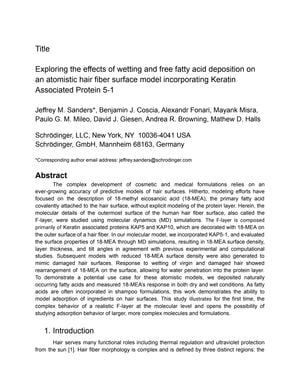Exploring the Effects of Wetting and Free Fatty Acid Deposition on a Hair Fiber Surface Model Incorporating Keratin Associated Protein 5-1
November 2022

TLDR Water and fatty acids affect hair's surface differently based on hair damage, and models can help understand hair-cosmetic interactions.
The document details a study using molecular dynamics simulations to explore the surface properties of hair fibers, particularly the effects of wetting and free fatty acid deposition on a hair fiber surface model incorporating Keratin Associated Protein 5-1 (KAP5-1). The study modeled virgin, lightly damaged, and moderately damaged hair by varying the density of 18-MEA, a lipid on the hair surface. Results indicated that water and fatty acids reorganize the 18-MEA layer, with more water penetration as damage increases. Fatty acids were found to contribute to a densely packed hydrophobic surface. The study concludes that these models can be used to understand interactions between cosmetic ingredients and hair and supports the idea that hair surface properties can be understood through a combination of different model types. Further computational studies are suggested to deepen understanding of hair fiber surface behavior.